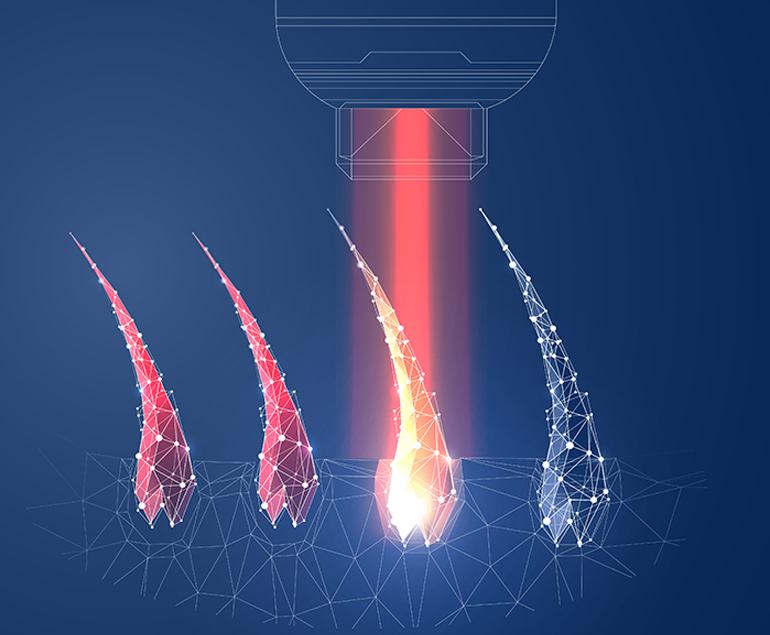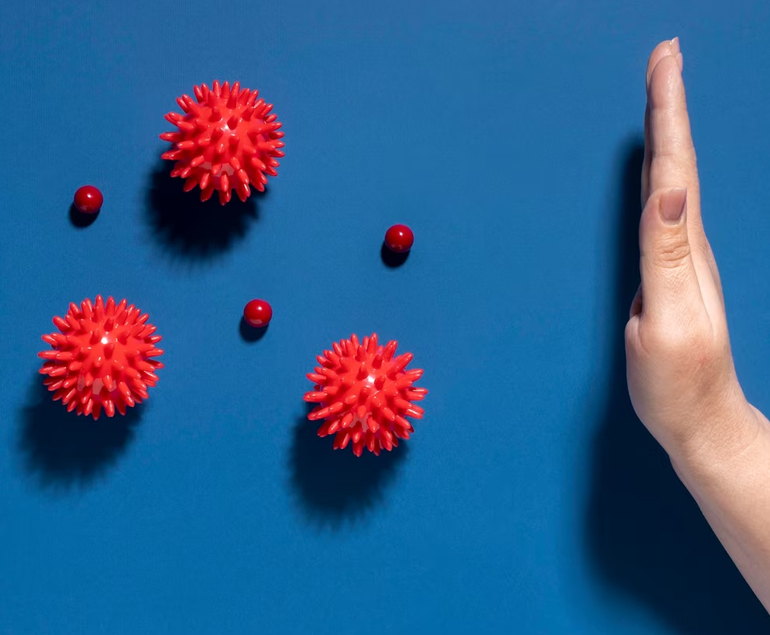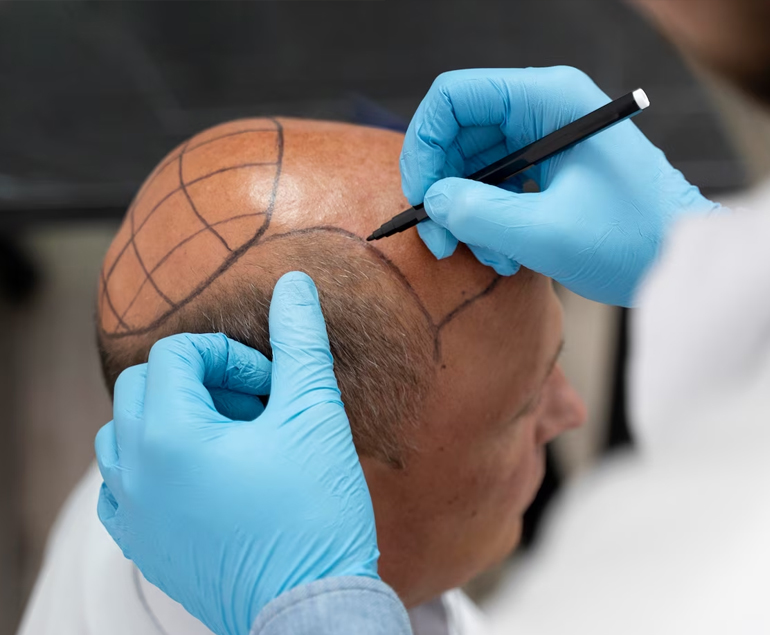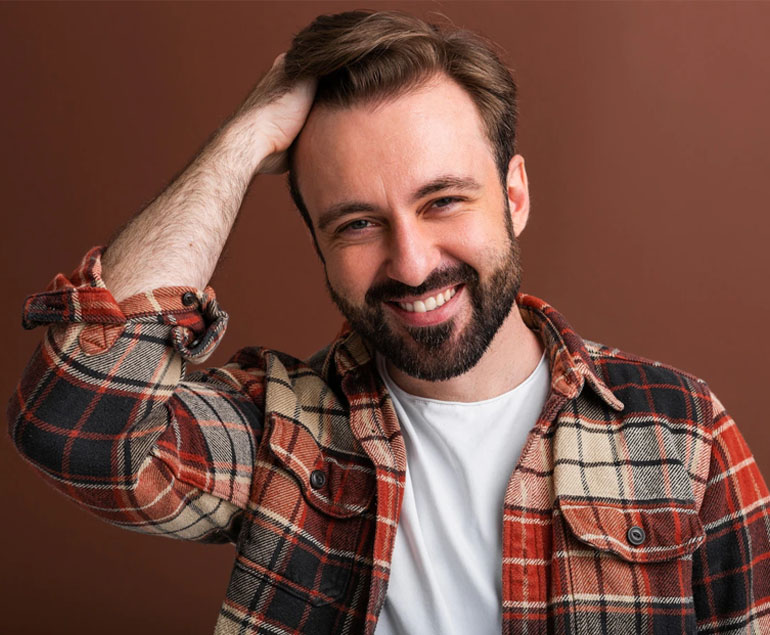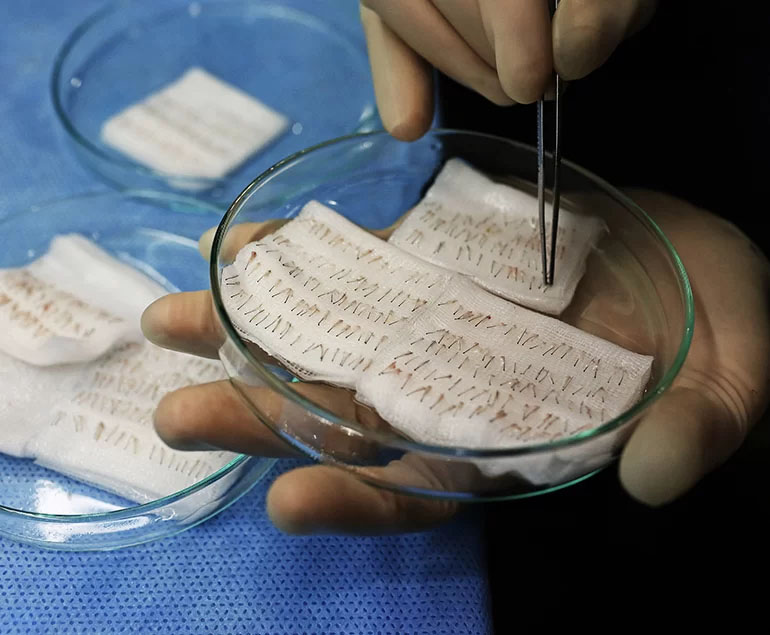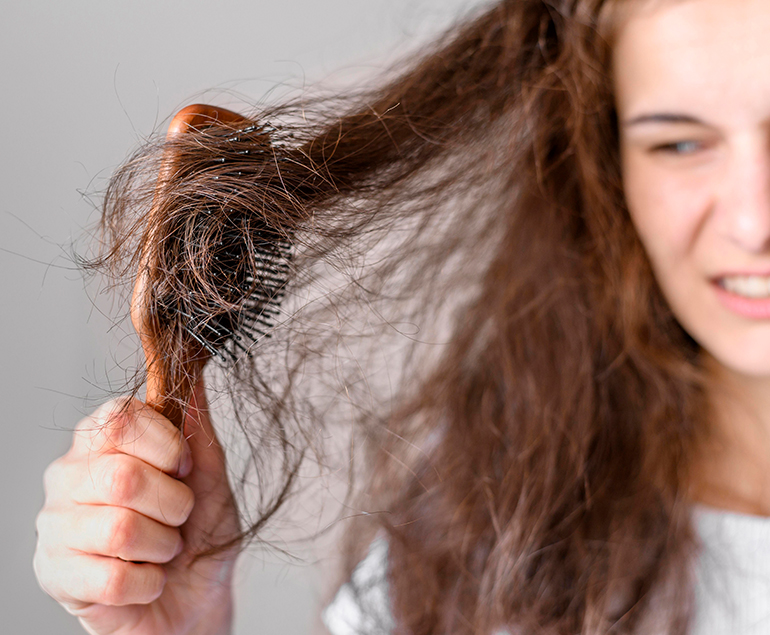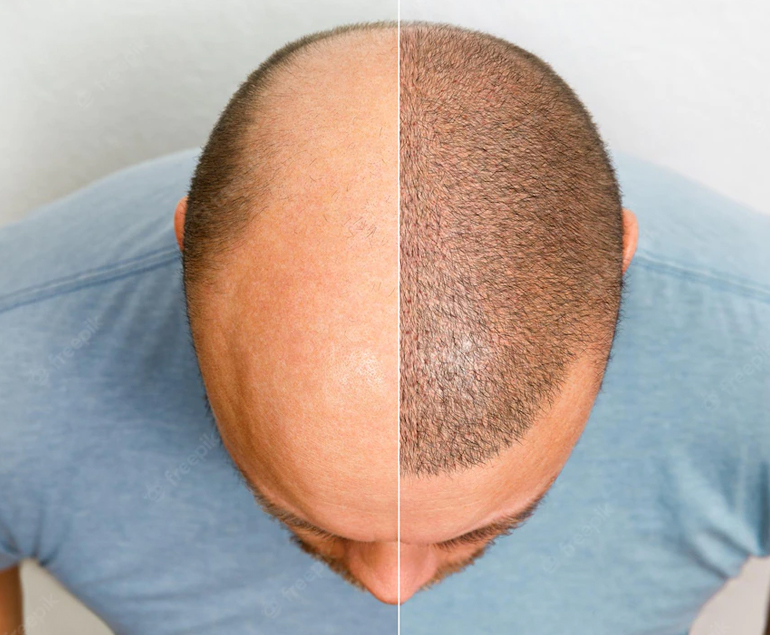What is Hair Laser? What are its Effects?
Hair laser is a treatment method used to prevent hair loss or to promote hair growth. The hair laser stimulates hair follicles by focusing low-level laser beams on the scalp and increases cellular activity. This treatment method promotes hair growth by supporting the health of the scalp.
The effects of hair laser treatment can be as follows:
- Promotes Hair Growth: Hair laser stimulates hair follicles. Low-level laser beams strengthen hair roots and promote hair growth. This helps to thicken thinning hair and assists the growth of new hair.
- Reduces Hair Loss: Hair loss usually occurs as a result of the weakening or inactivity of hair follicles. Hair laser treatment stimulates hair follicles, reducing hair loss. It allows for denser hair growth in areas made sparse by hair loss.
- Nourishes the Scalp: Hair laser increases blood circulation in the scalp, allowing more oxygen and nutrients to be delivered to the hair roots. This makes the scalp healthier and promotes hair growth.
- Improves Hair Quality: Hair laser treatment supports the hair strands to be thicker, healthier, and stronger. This makes the hair look fuller and shinier.
- Reduces Inflammation: Hair loss and hair diseases can sometimes cause inflammation in the scalp. Hair laser treatment reduces inflammation in the scalp and creates a healthy scalp environment.
The effects of hair laser treatment can vary from person to person. It is important to apply the treatment regularly and continue for the recommended period for the treatment to be effective.
In conclusion, hair laser treatment is a method used to promote hair growth and reduce hair loss. It stimulates hair roots by increasing cellular activity in the scalp and supports the hair to grow thicker and healthier. It is important to consult a hair transplant specialist to get more information about hair laser treatment and to evaluate treatment options.
Complications and Things to Know in Hair Transplantation
Hair transplantation is an effective solution for many people to solve the problem of hair loss. However, like every surgical procedure, hair transplantation can also involve potential complications. Therefore, there are some important issues that everyone considering hair transplantation needs to know. Here are the possible complications in hair transplantation:
- Infections: As with any surgical procedure, hair transplantation carries a risk of infection. Infections can generally be treated with antibiotics, but in severe cases, additional intervention may be required. It is important to have the procedure performed in a hygienic environment by a skilled surgeon to minimize the risk of infection.
- Non-Acceptance of Hair: In some cases, the hair follicles in the recipient area may reject the transplanted hair. This means that the hair transplant may fail. To prevent such a complication, it is important to have a careful evaluation before the hair transplant and to identify suitable candidates.
- Cyst Formation: Although it is a rare complication, cysts can form after hair transplantation. Cysts are fluid-filled sacs that form as a result of hair roots accumulating under the skin. Cysts can usually be painful and may require additional intervention.
- Scar Formation: After the hair transplant procedure, scars can form in the recipient and donor areas. Scars can cause permanent marks on the skin. Therefore, the technical skill of the surgeon and careful post-operative care are important.
- Temporary Shock Loss: After hair transplantation, some people may encounter a condition called temporary shock loss. This condition means that the transplanted hairs fall out after a while. However, this is a temporary situation and the hair starts to grow back later.
- Risks Related to Anesthesia: Hair transplant procedures are usually performed under local anesthesia. Every anesthesia method involves some risks. Although complications related to anesthesia are rare, your surgeon will provide you with detailed information before the anesthesia.
In conclusion, hair transplantation can involve potential complications. However, these complications are generally rare and the risk is further reduced in procedures performed by a specialist surgeon. It is important for everyone considering hair transplantation to have a detailed evaluation beforehand and understand the potential risks.
What is the Best Technique for Hair Transplantation?
Hair transplantation is a solution that offers permanent and natural results for people suffering from hair loss. However, it can be difficult to choose among the different techniques used in hair transplantation. Each technique has different advantages and the best technique should be determined considering the person’s hair situation, expectations, and preferences. Here’s what you need to know about the best technique in hair transplantation:
1. FUE (Follicular Unit Extraction)
FUE is the most commonly used hair transplantation technique today. In this technique, hair follicles are individually extracted and placed in the area to be implanted. The advantages of FUE include minimal invasiveness, rapid healing process, and natural results. Also, it is possible to achieve denser hair distribution with the FUE method.
2. DHI (Direct Hair Implantation)
DHI is a technique where a special device is used for hair transplantation. In this technique, the hair roots are transferred to the area to be implanted while they are being collected. The advantages of DHI include a faster healing process, dense hair distribution, and less procedure necessity. However, the DHI method can generally be more costly.
3. FUT (Follicular Unit Transplantation)
FUT is an old technique in hair transplantation. In this technique, a strip of hair-bearing skin is taken and the hair roots on this strip are separated and placed in the areas to be implanted. The advantages of FUT include denser hair distribution and it is generally more economical. However, because the FUT method is a more invasive procedure, the recovery process can be longer and it can leave a visible scar.
4. Robotic Hair Transplantation
In recent years, robotic hair transplantation technology has also improved. Robotic systems work with high precision to collect hair follicles and perform the transplant. Robotic hair transplantation is a method used to achieve faster and more accurate results. However, this technology is not yet widely used and its cost may be higher than other techniques.
In conclusion, the best technique in hair transplantation varies depending on the person’s hair situation, expectations, and preferences. Each technique has different advantages and the most suitable technique should be determined as a result of a detailed evaluation with a hair transplantation specialist. When making a decision about hair transplantation, it is important to trust expert opinions and experience.
What Are the Positive Effects of Hair Transplantation on Men?
What Are the Positive Effects of Hair Transplantation on Men?
Although hair loss is generalized as “genetic”, scientifically malnutrition, hormonal imbalances and psychological factors are the main causes of hair loss. When transplanting after a hair loss, you will feel the change in your deepest parts in almost every aspect of your life. Because this situation leaves a positive impact on psychology in particular, it will have an impact on all areas of your life. So, what are these positive effects in psychology?
Your self-confidence increases!
When you stand in front of the mirror and look at yourself and you don’t like yourself, you suffer from a lack of self-confidence. This situation is one of the main reasons why people get depressed. This situation is reflected in the way you express yourself in the community, except that you don’t like yourself. Since you do not have confidence in yourself, the question of “I wonder what they will say” is always on your mind. However, a self-confident individual achieves the happiness of living in peace by expressing him/herself comfortably instead of examining the ideas of the other person.
Climb the career ladder!
Although making you feel aware in your business life is related to how much your skills and competencies sought for your job match with this job, “Appearance” means a lot. Your diction, appearance and communication should first attract attention so that they are then interested in how you do it. Who does not want to have an aesthetic, remarkable appearance? Be sure that your rising self-confidence and striking natural design will reflect on you as an advantage in your business life.
You can place the Positive Effect of Hair Transplantation on Men in almost every area of life except these. Because when the problem of baldness, which extends to the natural appearance and “obsession” is eliminated, the effect of the improved psychology and the rising self-worth of the person as a result of the rising self-confidence will help him to become a more popular person in every work s/he does. Beautiful appearance, self-confidence, which reveals the awareness of people’s inner self, is at the beginning of the most basic building blocks of our lives.
Why Should I Have a Hair Transplant in Turkey?
Why Should I Have a Hair Transplant in Turkey?
It is perhaps one of the most curious questions of people who decide for hair transplantation and are looking for this procedure. They engage in constant research to make the most accurate and beneficial decision for this procedure, which they will do once in their lives. For this operation, where many people, not only from Turkey but also from abroad, prefer Turkey, there are countless advantages that will make their choice justified.
Why is Turkey the heart of hair transplantation?
There are two different answers to this question. While the first of these can be considered as technological possibilities, the other is the operation fee. Did you know that within the scope of a statistical study, there is a 10 times more difference between the price demanded as a result of hair transplantation in Turkey and the number in America? Or that this process is done for 5 times more on average in Germany? As you can see, people can get the chance to have a hair transplant with very advantageous numbers, even if they come from there and spend days on vacation here. As you can see, there are financial factors behind the fact that they come to Turkey from abroad and have a hair transplant.
In addition to its low price policy, Turkey is able to stand out from the rest with the increase in the level of expertise and the abundance of technological opportunities. Many surgeons in Turkey go abroad to conduct special research on these issues. The wide market that emerged as a result of the desire of individuals from both domestic and abroad to have hair transplant confirms the desire of different companies to benefit from this market. Companies are constantly investing in order to stay in the sector, so it is inevitable to use the latest technological devices in Turkey.
The excess in the number of operations also brings “operational mastery”. Do you think an individual who has a hair transplant once in 3 days is more experienced or someone who transplants every day? The continuity and existence of the work causes the surgeons who transplant to work in a more conscious and experienced way.
For this reason, Turkey has come to a position that can almost be called the center of the world for hair transplantation. The increase in investments is another factor in the rapid development of the sector.
What are the Latest Technology Used in Hair Transplantation?
What are the Latest Technology Used in Hair Transplantation?
After deciding on hair transplantation, another research subject is the hair transplantation technique to be used. Turkey is one of the most important health institutions in the world for hair transplantation. This causes the most common and valid techniques to be used, and even to be constantly renewed and developed. So, what are these techniques?
FUE Technique
The FUE Technique has been used extensively for the last 15 years, on average, by being continuously expanded. For the hair to be transplanted according to the Fue Technique, the hair is collected one by one from the nape area and supplied to the area to be transplanted. The hair follicles extracted with a method called manual puch or a device called a micro motor specially developed for this method are kept in a cold environment accompanied by a special solution. Then, the process is completed by placing them one by one in the area to be planted. Although the duration of the procedure is longer, this technique is often preferred because it takes a shorter time to recover and return to normal life. Of course, the number to be planted will be in parallel at the rate that can be obtained from the nape region.
DHI Technique
DHI Hair Transplantation method is called Direct Hair Transplant. This technique cannot be used alone, it is used together with the Fue technique. Hair follicles collected within the scope of the Fue technique are transplanted according to the Fue technique. But the biggest difference here is that with a special pen, the canal is opened and the hair transplant is done at the same time. This allows for frequent planting and obtaining a dense appearance. Apart from total hair loss, it is the most preferred method for people with thin hair to tighten their hair.
Robotic Technique
Robotic Technique is the entry of developing technology into the sector. Because it is a system based entirely on technology. In the robotic technique, the collection of hair follicles and replanting are done entirely with the help of computers. The process is completely based on the Fue technique. However, while all processes are carried out manually with human sanction, here all processes are developed under computer control.
What Are The Auxiliary Treatments To Be Applied At Home To Delay Hair Loss?
What Are The Auxiliary Treatments To Be Applied At Home To Delay Hair Loss?
It is possible to prevent your hair from falling out and to make it look radiant! They need a little attention like everything else. Although stress and genetic factors are very important in hair loss, with some applications, you can delay the hair loss process as much as possible or even stop it completely. Well, what are they?
What can be done at home to prevent hair loss?
First of all, you need to know that whatever you do, your hair will fall out. What matters is the amount of hair loss. You may observe some rash while washing and combing your hair. Losing 50-100 strands of hair per day is considered normal. But if you see thinning in your hair, if it exceeds 100 strands on average, this can be listed as signs that you are progressing towards baldness. Although this is due to different reasons such as iron deficiency, you can restore your hair to its old appearance with simple methods at home. There are some rules you just have to follow.
- Avoid washing your hair every day. Also, do not use very boiling water during washing. Try to wash with warm water every other day as much as possible. While washing your hair, lather by massaging the roots. Also, be careful not to use soap and shampoo more than 2 times.
- Electronic devices such as hair dryers and hair straighteners burn and weaken your hair. Therefore, do not use it as much as possible.
- You need to pay attention to the products you consume. You need to eat plenty of protein to nourish the hair follicles. Beans, fat-free yogurt, lentils, eggs and cheese are among the most useful and useful products that you can consume in the most practical way.
- Drink two glasses of milk a week to meet the need for vitamin A. In addition, it will be to your advantage to eat chicken breast, legumes, egg yolk, cauliflower or potatoes 2-3 times.
- Eat 1 cup of pumpkin seeds every day.
- The consumption of carrots, which protects the scalp by nourishing the hair follicles, is very important. Make sure to consume at least one a day.
- Choose suitable shampoo and soap for your hair, stay away from dandruff-producing products.
How Is The Treatment Process After Hair Transplantation?
How Is The Treatment Process After Hair Transplantation?
Apart from the importance of proper hair transplantation, the treatment and healing process after hair transplantation is also of great importance. It is very important for the transplanted individual to comply with what the physician wants to implement within the scope of treatment recommendations. Otherwise, it is not possible for the planting to be successful and the desired result to be achieved. There are rules that must be followed for a few days after hair transplantation. One of them is the regular use of drugs and solutions that the doctor wants to use after the operation.
What should be considered in the Treatment Process After Hair Transplantation?
The Treatment Process after Hair Transplantation is carried out under the supervision of a physician. However, we cannot pass without mentioning the healthiest and most applied methods.
- It is very important that the head does not sweat, especially in the first 3 days after hair transplantation.
- You need to avoid stress as much as possible.
- You need to obtain the solutions that the doctor recommends to you and use them at the rate s/he mentions.
- You should use the antibiotic drug that you are told to drink regularly, without delaying even a minute.
- If you feel a lot of pain or ache, you can take the painkiller recommended by your doctor.
The first 3 days of hair transplantation are extremely important. In this process, it is absolutely essential that you do not touch your head with water. Unless there is an extreme situation after hair transplantation, the person who is transplanted is usually invited to the clinic for dressing by the physician. While dressing is being done here, the doctor also examines. After the 3-day process, it informs about how to wash the hair and the rules to be followed.
You should definitely avoid stress during the treatment. You also have to avoid the sun to prevent sweating. If you have to go out, it will be to your advantage to prefer cotton hats that will prevent sweating. Also, don’t always put your hand on your head. Always keep in mind that you have a head wound. This is a completely open wound. Putting your hand on your head causes the germs on your hand to come into contact with your head. The microbes here will also combine with the open wound on your head, increasing your chances of getting an infection. Therefore, you should complete the treatment process as much as possible without touching your head, sweating or touching water.
What are the effects of Epigenetics on hair loss?
What are the effects of Epigenetics on hair loss?
People generally associate all hair loss with genetic factors. So, how true is this? Is it really genetic? And nothing to do with it? First of all, let’s examine what exactly epigenetics is.
What is Epigenetics?
The term epigenetics is used in biology as the science that includes changes in gene expression that are not caused by changes in the DNA sequence, but are also hereditary.
Through epigenetic mechanisms, parents can transmit the effects of the environment they have lived through to their children and even to their grandchildren who will come a few generations later. Although we do not want to blow your mind by expressing detailed explanations of epigenetic mechanisms here, let’s talk about the main lines, albeit partially.
DNA methylation, also known as the addition of chemical methyl to DNA, causes the expression of the relevant gene to change, apart from suppressing the methylation of DNA. With the help of these mechanisms, the change of gene expression is affected by environmental conditions in parallel, and the epigenome can change even if the DNA sequence of the individual, in other words, the genome does not change. When we look at identical twins with the same genome, the fact that the epigenetic profiles are completely different shows that these mechanisms are more active than previously thought, and apart from all these, they may be effective in heredity.
The scientific explanation above also shows that it directly affects epigenetic hair loss. So, is this incurable?
Is epigenetic therapy possible?
With the developing technology, this is now possible. You can treat epigenetics. However, the most important method you should pay attention to here is to wait for the hair to regrow as part of the Epigenetic treatment method. The treatment is all about protecting the hair. It aims to eliminate existing hair loss.
Within the scope of epigenetic treatment, the causes of hair loss are examined one by one. Undesirable conditions such as environmental factors, stress, genetic factors are the most common causes. With the elimination of these reasons, hair loss is greatly reduced. Keratin is the most common system when using the epigenetic treatment method. Increasing the amount of keratin is one of the factors that minimizes the rate of hair loss.


